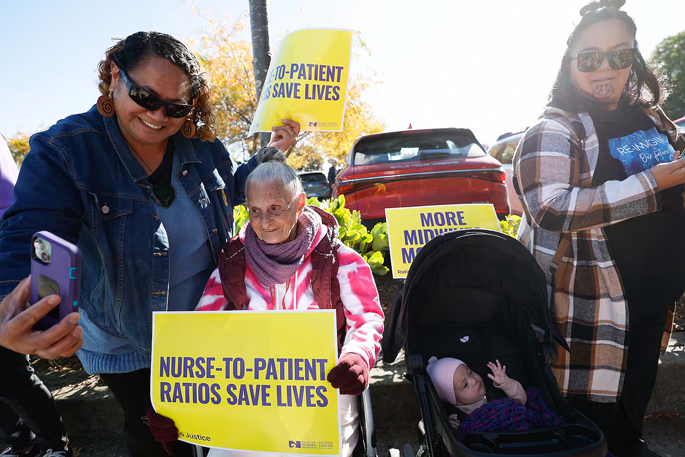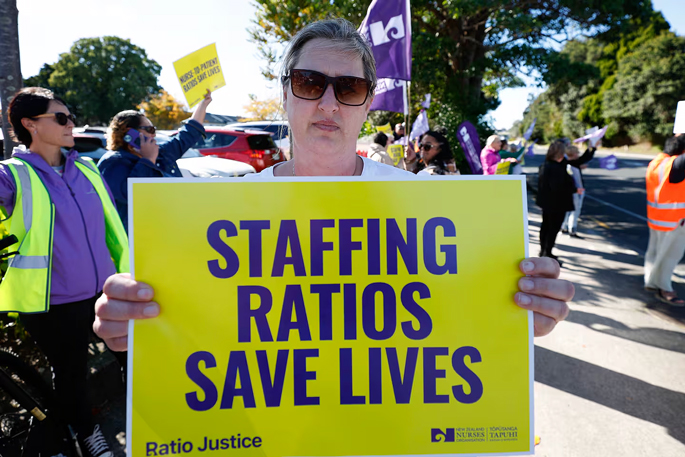Nurses are finishing their shifts “distraught and upset” because of understaffing in Te Whatu Ora hospitals, a union delegate says.
It comes as new data shows one in four Te Whatu Ora hospital shifts, on average, were understaffed last year.
Te Whatu Ora says it is “extremely conscious” of the impact of shortages and has made “significant” headway in addressing it, including recruitment, training and increasing pay.
Members of the New Zealand Nurses Organisation gathered outside Tauranga Hospital on Thursday, as rallies took place in 22 locations across the country ahead of the Budget being announced on May 30.
NZNO delegate and Tauranga Hospital nurse Lucy Waller says nurses are running short-staffed “all the time” and the impact is “soul-destroying”.
“You have your patients that really need you and you can’t be there for them, which makes it really difficult to do your job ...
“It leaves you feeling burnt out – you leave your shifts distraught and upset.”
A nurse for 20 years, Kucy says she wants legally enforceable nurse-to-patient ratios.
She knows many nurses who have gone to Australia to work because of better ratios.
“They feel supported, they know that they’re going to be able to provide for their patients ... and they know that it’s strictly adhered to because, when it’s not, there’s penalties.”
‘The burnout is real’
Shannyn Bristowe, an NZNO delegate and third-year student nurse at Te Whare Wānanga o Awanuiārangi, says members are rallying for “ratio justice”.
“The burnout is real ... we do not have enough nurses ... to provide good care for our patients,” says Shannyn, who does nursing placements at Whakatāne Hospital.
 Shannyn Bristowe, an NZNO delegate and third-year student nurse, speaking at a rally outside Tauranga Hospital. Photo / Alex Cairns.
Shannyn Bristowe, an NZNO delegate and third-year student nurse, speaking at a rally outside Tauranga Hospital. Photo / Alex Cairns.
“We also need to ensure that we’re creating a culturally appropriate nurse-to-patient ratio because we do really need to focus on building up our Māori nursing workforce.”
There are disparities in the health of Māori and Pasifika whānau “because of the lack thereof”.
“The Government must prioritise investing in both the present and future workforce.”
Data reveals ‘alarming’ nursing crisis
An NZNO media release says it received information under the Official Information Act revealing the “alarming” nurse staffing crisis in public hospitals.
The average of one in four shifts being understaffed last year equated to 158,966 “shifts below target”.
Capital, Coast and Hutt Valley recorded the highest number of understaffed shifts with 22,163.
Bay of Plenty recorded 5393 understaffed shifts last year and Lakes recorded 2951.
 Nurse Amber Benson attending the rally outside Tauranga Hospital. Photo / Alex Cairns.
Nurse Amber Benson attending the rally outside Tauranga Hospital. Photo / Alex Cairns.
NZNO chief executive Paul Goulter says shifts below target indicate a heightened level of risk for patient safety, patient outcomes and nursing workforce safety.
Patient mortality increases with exposure to increased numbers of shifts below target, he says.
“We simply cannot afford any further service or funding cuts”.
NZNO kaiwhakahaere Kerri Nuku says nurse-to-patient ratios had been implemented in Australia, California, British Columbia, Ireland and Wales with “exceptional results” for nurses, patients and health budgets.
Te Whatu Ora: ‘We understand the risks very well’
Christine Lowry, Health NZ Te Whatu Ora’s acting national director for hospital and specialist services, acknowledges nurse staffing has been challenging.
The OIA figures reflect a wider issue of health workforce shortages in New Zealand and internationally, which Health NZ has made “significant” headway in addressing.
As of July 2023, it was estimated New Zealand was short about 4800 nurses.
“We are extremely conscious of the impact of these shortages, on patients, nurses themselves and the wider health system. We understand the risks very well.”
The number of nurses employed by Health NZ rose in 2023 by almost 2500 compared with December 2022, she says.
As at December 2023, the vacancy rate for nurses was down to 6 per cent. There were about 28,200 nursing full-time equivalents across Health NZ, about 38 per cent of its total workforce.
Between August 2022 and March 2024, it supported 3200 internationally qualified nurses to complete a competence assessment programme.
To qualify, nurses were required to have a confirmed offer of employment in a direct patient-facing role, such as in hospitals, aged care facilities, GP practices or with mental health and addictions services.
“Changes to health immigration settings have made a huge difference in making New Zealand attractive to overseas-trained nurses.”
While this has helped to close many generalist nursing vacancies, Health NZ continued to recruit overseas for specialist nurses.
Christine says it's equally focused on increasing the domestic workforce.
There are 7400 degree-level nursing students training at any given time, alongside a smaller cohort of enrolled nursing students.
Bachelor of Nursing clinical placements have grown by 80 in 2024, she says.
Te Whatu Ora is also focused on ensuring enrolled nurses were supported and was working with Te Pūkenga and the Nursing Council to develop a national, full-time work, part-time study option.
Nursing pay rises by up to 60 per cent since 2017
Since 2017, the starting salary for a graduate nurse has risen from about $49,500 to $75,500 – a 53.2 per cent increase, says Christine.
The top step for a registered nurse had risen from $66,750 to $106,739 – a 60 per cent increase.
The top step for a senior nurse had risen from $115,000 to $162,800 – a 41.6 per cent increase.
This did not include the $25,000 lump sum for pay equity paid in two tranches in 2023.
 Waitangi Nathan (health care assistant), Molly Happi, Sydney Wharewera-Rua (4 months old) and Stacey Wharewera (third-year student nurse and NZNO delegate) at the rally outside Tauranga Hospital. Photo / Alex Cairns.
Waitangi Nathan (health care assistant), Molly Happi, Sydney Wharewera-Rua (4 months old) and Stacey Wharewera (third-year student nurse and NZNO delegate) at the rally outside Tauranga Hospital. Photo / Alex Cairns.
Christine says Health NZ focused on upskilling nurses, for example through the Nurse Practitioner Training Programme, which this year had its highest intake of 121 participants.
The latest data from the Nursing Council shows there are 77,634 nurses with current annual practising certificates, up from 68,277 two years ago.
“However, the demand for nurses is not static, it continues to grow due to a growing and ageing population. So we will remain focused on this area.”



0 comments
Leave a Comment
You must be logged in to make a comment.